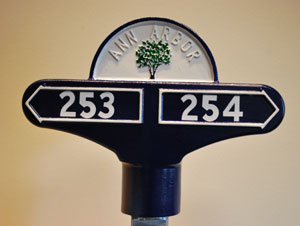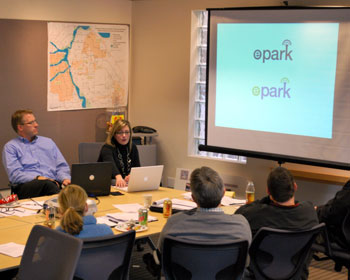E-Park Stations to Replace Parking Meters

It's not the final design, but something like this will replace parking meters. Parkers will need to remember their space number so that they can enter it at the E-Park station where payment will be made.
On Wednesday morning, the Downtown Development Authority board operations committee got an update on the new parking payment kiosks which will soon begin replacing downtown Ann Arbor parking meters. The plan to install the devices, which will allow flexibility for payment and for rate-setting, has been reported in The Chronicle at least as long ago as last October.
The bases of the existing meters will remain in place, but they’ll be decapitated, with the coin receptacle to be replaced with a sign indicating a number for each parking space. The numbers are needed when parkers pay for their spaces.
On Wednesday, Joe Morehouse, deputy director of the DDA, said that the first of 25 units will be shipped on April 1 for deployment in the State Street and Liberty Street area. The 25 units represent an initial phase of assessment, with the idea that as many as 150-175 of these “smart meters” could eventually be installed.
In the first two paragraphs, we’ve described these parking meter replacements as: “kiosks,” “devices,” “units,” and “smart meters.”
But if Angela Pierro of Zero Gravity Designs is successful in the execution of her identity and branding strategy for the roll-out of these advanced parking payment appliances, Chronicle readers will be calling them “E-Park stations.”
Zero Gravity has been hired by the DDA to handle the promotion and public relations for the E-Park stations. Pierro walked the operations committee through the considerations that led to the development of the name and logo. Descriptions like “efficient,” “ease of use,” and “environmentally friendly,” and “innovative” (the E-Park stations are connected wirelessly) played a role in the naming. Important for the logo, Pierro said, was that it should reflect the wireless capability. The E-Park stations’ wireless connectivity not only allows payment with a credit card, but also allows parkers to add money to their payment via cell phone.
Asked by The Chronicle if this would make the feed-the-meter option used by some downtown workers even more attractive, Susan Pollay, executive director of the DDA, pointed out that the two-hour limit will still be in place.

Angela Pierro of Zero Gravity Designs shows the DDA operations committee the logo for E-Park. The top version shows that it works without color. The colors in the bottom version are consistent with the colors in the wayfinding project the DDA is currenlty working on.
An additional benefit from the wireless capability of the E-Park stations is that payment can be made at any station, not just at the closest one – which might be in the opposite direction of the parker’s destination.
That is, even if there’s an E-Park station 10 yards to the east of a parking space, if a parker is ultimately headed west, that would represent an extra 20 yards of walking, which could be a lot depending on a parker’s circumstances. No need to traverse that extra 20 yards. There’s also no need to return to the vehicle to put a ticket on the windshield. Ann Arbor’s E-Park stations are not a pay-and-display system.
The logo that Pierro showed the operations committee conveys the wireless aspect of the E-Park stations through concentric semi-circles emanating from the top of the “K” in E-Park.
Roger Hewitt, chair of the operations committee, suggested that the signs indicating the number of the spaces needed to clearly indicate that parkers needed to pay at an E-Park station. And alluding to a preceding intense discussion by the committee on the relationship between the city of Ann Arbor and the DDA (to be reported in a separate Chronicle article), board member John Splitt joked that the signs should say that all monies go directly to the city of Ann Arbor general fund.

Susan Pollay, executive director of the DDA, shows the operations committee the prototype of the signs that will replace the parking meters when E-Park is rolled out.
Splitt elicited some additional chuckles from his DDA board colleagues when he asked: “What will this [the "E" in E-Park] stand for if it doesn’t go well? Evil?” Board member Russ Collins, in the same spirit, mused, “Take your computer for a walk … to an E-Park.” But board member Leah Gunn, who had to leave a few minutes before the end of the meeting, said in parting: “I like E-Park!”
In response to Pierro’s description of using “ambassadors” (people who would be physically present when the E-Park stations first appear, looking to assist “dazed and confused” parkers and “creating buzz”), Collins seemed a little uncertain. For the ambassadors, Collins said, he was seeing a sash and a hat, but buzz?? Pierro allowed that by “buzz” she meant positive PR. Part of that effort would include online social networking tools like a Facebook page and a blog, as well as more traditional materials like a brochure.
At the mention of brochures, Mark Lyons, general manager of Republic Parking, suggested that they could be handed to drivers by booth attendants at structures and lots. Lyons, newly arrived in town (two weeks), succeeds Tony Bisesi. Lyons is a native Floridian, but he’s lived in Saline, Mich. previously.




I think these meters are a great idea, but will not the all day parker be encouraged to go and move one space in the morning, leave for lunch at noon, and then move one space in the afternoon. He or she would now be able to park all day, plus be notified when the meter has expired, so as they can run out and move the car. We have this same problem without meters in Bloomington, IL. Good luck!
Will the removed, old-style meters be available for sale? I’d like to own one and the city or the DDA could use the revenue from their sale I’m sure.
I actually inquired with Joe Morehouse about that. Unlikely they’d be for sale locally. There’s a market for used meters, and they’re dealt with in large “lots” as opposed to single meters. The DDA will get some cash out of them.
To respond to Mr. Fike – the city still chalks tires for overtime in parking meter spaces. If someone moves her/his car, there isn’t much anyone can do about it, but all day parkers tend to park in structures or lots. The meters in the downtown generally are 1 or 2 hours, so this doesn’t work well for all day parkers.
I hate the meter stations at the lot on Main Street next to Real Seafood and on North Campus near Bonisteel.
They do not have a very good track record on actually accepting bills.
Mr. Zimmerman, the pay stations being installed by the DDA will only accept coins or credit/debit cards because of the problems all bill accepting machines have.
It’s too bad the signs are small and/or lack a loop. It will make them not viable as a spot to lock a bike. It would be nice if the replacement “heads” facilitated locking a bike.
Joe, that’s good news!
I agree with #7. Apparently there is a lack of bike parking (link to Chronicle article). The city is applying for another Bicycle Friendly Community Award from the League of American Bicyclist, so it is in the city’s best interest to incorporate a bike locking feature to the parking signage.
It would be nice if the meters had a credit card “check in/check out” feature like they use at Metro Airport (i.e., you slide your card in on entry and again upon exiting and the system computes your usage.)
Mr. Martel, the problem with that feature with this equipment is what to do when a user forgets to credit card out and gets charged for more time than what they used.
Yes, the transition to kiosks presents an excellent opportunity for the DDA to create more badly needed bike parking at a fraction of the cost it would take to build new racks. You can see an example of such a conversion here.
I’m going to e-mail Susan Pollay to encourage the DDA to choose this two-birds, one-stone approach, and I encourage others to do so as well: dda@a2dda.org.